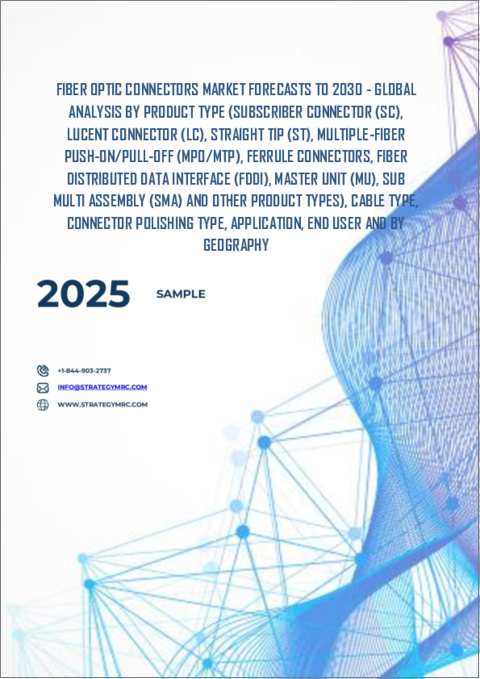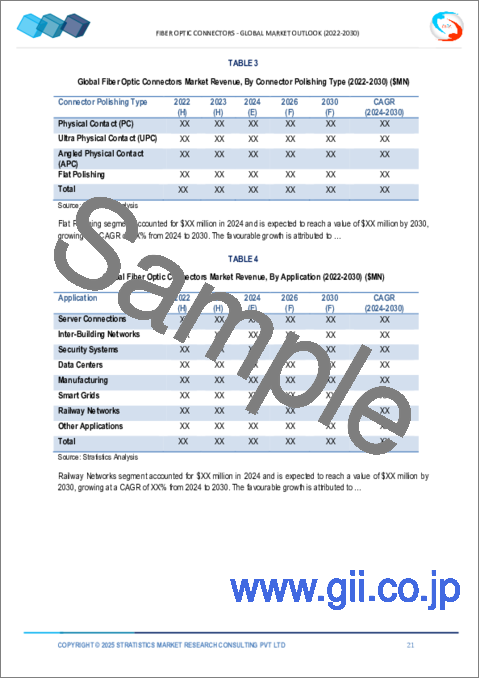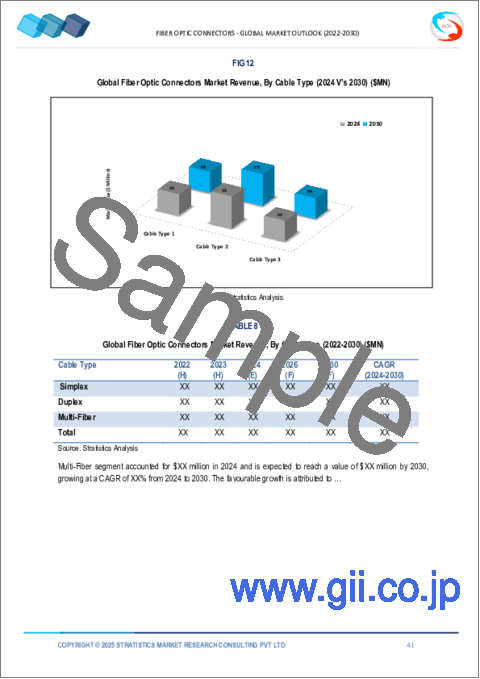|
|
市場調査レポート
商品コード
1617154
光ファイバーコネクタの2030年までの市場予測: 製品タイプ、ケーブルタイプ、コネクタ研磨タイプ、用途、エンドユーザー、地域別の世界分析Fiber Optic Connectors Market Forecasts to 2030 - Global Analysis By Product Type, Cable Type, Connector Polishing Type, Application, End User and By Geography |
||||||
カスタマイズ可能
|
|||||||
| 光ファイバーコネクタの2030年までの市場予測: 製品タイプ、ケーブルタイプ、コネクタ研磨タイプ、用途、エンドユーザー、地域別の世界分析 |
|
出版日: 2024年12月11日
発行: Stratistics Market Research Consulting
ページ情報: 英文 200+ Pages
納期: 2~3営業日
|
全表示
- 概要
- 図表
- 目次
Stratistics MRCによると、世界の光ファイバコネクタ市場は2024年に56億米ドルを占め、予測期間中にCAGR 7.9%で成長し、2030年には88億米ドルに達する見込みです。
光ファイバコネクタは、光ファイバ通信システムにおいて重要なコンポーネントであり、データトランスミッションのための光ファイバの安全かつ効率的な接続を可能にします。これらのコネクタは、シグナルインテグリティを損なうことなく、ファイバの接続や切断を容易にします。光損失を最小限に抑え、信号の反射を低減し、高速通信ネットワークにおける高品質なパフォーマンスを保証するように設計されています。精密な設計と耐久性により、多様なネットワーク環境において信頼性の高い長距離データ転送を実現します。
シスコの調査によると、今年のインターネットトラフィックの82%はビデオによるものだといいます。帯域幅の需要は通常、年間約50%増加します。ライトな家庭のインターネット・ユーザーであれば、現在は5~10Mbpsで十分かもしれないが、5年後には、同様の体験を提供するために40Mbps近くが必要になると予想されます。10年後には、これは驚異的な300Mbpsに成長すると思われます。
5Gネットワークに対する需要の高まり
5Gネットワークに対する需要の高まりが市場を大きく押し上げています。5G技術では、より高速で信頼性の高いデータ伝送と低遅延が求められるため、高性能光ファイバー接続のニーズが急増しています。これらのコネクターは、5Gネットワークの広大なインフラをサポートし、データセンター、通信、基地局間の効率的な信号伝送を確保するために不可欠であり、市場の成長とコネクター技術の革新を促進しています。
物理的損傷に対する感度
光ファイバーコネクターの物理的損傷に対する感度は、市場で大きな課題となっています。これらのコネクタは、特に過酷な環境では磨耗や損傷を受けやすく、信号の損失、性能の低下、潜在的なネットワークの中断につながります。このような脆弱性は、メンテナンスコストを増加させ、通信システムの信頼性を低下させ、市場の成長を妨げます。そのためメーカーは、物理的損傷の影響を最小限に抑えるため、耐久性と回復力の向上に注力しています。
データセンターの採用増加
データセンターの採用が増加していることが、市場の成長を促進しています。企業がデジタルオペレーションやクラウドベースのサービスを拡大するにつれ、より高速で信頼性の高いデータトランスミッションへの需要が高まっています。光ファイバーコネクターは、データセンター内の大容量サーバー、スイッチ、光学記憶装置をつなぎ、高速で低遅延の接続性を提供するために不可欠です。この動向は技術革新を促進し、データ集約型アプリケーションをサポートする高度な光ファイバーコネクターの必要性を高めています。
複雑な設置とメンテナンス
光ファイバーコネクターの設置やメンテナンスの複雑さは、市場の成長を妨げる可能性があります。光ファイバーコネクターの適切な設置や保守には、専門的な技術や設備が必要とされることが多く、人件費の増加やエラーの可能性につながります。このような複雑さは、ネットワークの展開を遅らせ、特に遠隔地や大規模な設置において、企業に課題をもたらす可能性があります。その結果、運用コストとダウンタイムを削減するため、よりシンプルでユーザーフレンドリーなソリューションがますます求められています。
COVID-19の影響:
COVID-19の流行は、サプライチェーン、製造、設置サービスを混乱させ、市場に悪影響を与えました。ロックダウンや規制により生産やプロジェクトのスケジュールに遅れが生じ、インフラ開発の減速により一部の地域では需要が減少しました。しかし、パンデミックの間、必要不可欠なサービスのための遠隔作業、デジタル通信、データセンターへの依存が高まったことも、高速接続への長期的なニーズを加速させ、将来の市場回復を後押ししました。
予測期間中、フェルールコネクタセグメントが最大になる見込み
フェルールコネクタセグメントは、コネクタ内の光ファイバの正確な位置合わせと固定を確実にするため、予測期間中最大の市場シェアを占めると予想されます。一般的にセラミック、ステンレススチール、またはプラスチックで作られたフェルールは、ファイバー端部を保護し、信号損失や歪みを最小限に抑えます。これらのコネクタは、通信、データセンター、産業用ネットワークなど様々な光ファイバアプリケーションで広く使用されており、効率的なデータ伝送のための高い信頼性と性能を提供しています。
予測期間中、通信セグメントが最も高いCAGRが見込まれる
通信分野は、予測期間中のCAGRが最も高くなると予想されています。より高速で信頼性の高い通信ネットワークへの需要が高まる中、光ファイバーコネクターは高速データ伝送を可能にする上で重要な役割を果たしています。これらのコネクタは、通信インフラにおける効率的な信号伝送を保証します。低遅延、大容量接続のニーズは、通信における光ファイバソリューションの技術革新と採用に引き続き拍車をかけています。
最大シェアの地域
北米地域は、高速インターネット、5Gインフラ、データセンター拡張の需要増に牽引され、予測期間中最大の市場シェアを占めると予測されています。この地域の先進的な通信・IT分野は、効率的で信頼性の高い接続のために光ファイバソリューションに大きく依存しています。さらに、スマート技術の採用とクラウドベースのサービスの成長が、高性能光ファイバコネクタのニーズをさらに押し上げ、同地域の市場拡大に拍車をかけています。
CAGRが最も高い地域:
予測期間中、アジア太平洋地域が最も高い成長率を記録すると見られています。この地域全体、特に中国、インド、シンガポールなどの国々におけるクラウドサービスやデータセンタの台頭も大きな要因です。光ファイバーコネクタは、高性能データセンターネットワークの構築に不可欠であり、これが主要な成長促進要因となっています。さらに、より小型で効率的、耐久性の高いコネクタの開発など、光ファイバコネクタの技術革新も市場開拓に貢献しています。
無料のカスタマイズ提供:
本レポートをご購読のお客様には、以下の無料カスタマイズオプションのいずれかをご利用いただけます:
- 企業プロファイル
- 追加市場プレイヤーの包括的プロファイリング(3社まで)
- 主要企業のSWOT分析(3社まで)
- 地域セグメンテーション
- 顧客の関心に応じた主要国の市場推計・予測・CAGR(注:フィージビリティチェックによる)
- 競合ベンチマーキング
- 製品ポートフォリオ、地理的プレゼンス、戦略的提携に基づく主要企業のベンチマーキング
目次
第1章 エグゼクティブサマリー
第2章 序文
- 概要
- ステークホルダー
- 調査範囲
- 調査手法
- データマイニング
- データ分析
- データ検証
- 調査アプローチ
- 調査情報源
- 1次調査情報源
- 2次調査情報源
- 前提条件
第3章 市場動向分析
- ドライバー
- 抑制要因
- 機会
- 脅威
- 製品分析
- 用途分析
- エンドユーザー分析
- 新興市場
- COVID-19の影響
第4章 ポーターのファイブフォース分析
- 供給企業の交渉力
- 買い手の交渉力
- 代替品の脅威
- 新規参入業者の脅威
- 競争企業間の敵対関係
第5章 世界の光ファイバーコネクタ市場:製品タイプ別
- 加入者コネクタ(SC)
- ルーセントコネクタ(LC)
- ストレートチップ(ST)
- マルチファイバープッシュオン/プルオフ(MPO/MTP)
- フェルールコネクタ
- ファイバー分散データインターフェース(FDDI)
- マスターユニット(MU)
- サブマルチアセンブリ(SMA)
- その他の製品タイプ
第6章 世界の光ファイバーコネクタ市場:ケーブルタイプ別
- シンプレックス
- デュプレックス
- マルチファイバー
第7章 世界の光ファイバーコネクタ市場:コネクタ研磨タイプ別
- 身体接触(PC)
- ウルトラフィジカルコンタクト(UPC)
- 角度付き物理的接触(APC)
- 平面研磨
第8章 世界の光ファイバーコネクタ市場:用途別
- サーバー接続
- 建物間ネットワーク
- セキュリティシステム
- データセンター
- 製造業
- スマートグリッド
- 鉄道ネットワーク
- その他の用途
第9章 世界の光ファイバーコネクタ市場:エンドユーザー別
- ヘルスケア
- 自動車
- 石油・ガス
- 通信
- 軍事・航空宇宙
- 鉱業
- その他のエンドユーザー
第10章 世界の光ファイバーコネクタ市場:地域別
- 北米
- 米国
- カナダ
- メキシコ
- 欧州
- ドイツ
- 英国
- イタリア
- フランス
- スペイン
- その他欧州
- アジア太平洋
- 日本
- 中国
- インド
- オーストラリア
- ニュージーランド
- 韓国
- その他アジア太平洋
- 南米
- アルゼンチン
- ブラジル
- チリ
- その他南米
- 中東・アフリカ
- サウジアラビア
- アラブ首長国連邦
- カタール
- 南アフリカ
- その他中東とアフリカ
第11章 主な発展
- 契約、パートナーシップ、コラボレーション、合弁事業
- 買収と合併
- 新製品発売
- 事業拡大
- その他の主要戦略
第12章 企業プロファイリング
- Corning Inc.
- Amphenol Corporation
- Molex LLC
- TE Connectivity
- Belden Inc.
- Phoenix Contact
- Hirose Electric Co. Ltd.
- Broadcom Inc.
- 3M Company
- Fujikura Ltd.
- Sick AG
- Sterlite Technologies Ltd.
- Keysight Technologies
- Soraa Inc.
- Commscope
List of Tables
- Table 1 Global Fiber Optic Connectors Market Outlook, By Region (2022-2030) ($MN)
- Table 2 Global Fiber Optic Connectors Market Outlook, By Product Type (2022-2030) ($MN)
- Table 3 Global Fiber Optic Connectors Market Outlook, By Subscriber Connector (SC) (2022-2030) ($MN)
- Table 4 Global Fiber Optic Connectors Market Outlook, By Lucent Connector (LC) (2022-2030) ($MN)
- Table 5 Global Fiber Optic Connectors Market Outlook, By Straight Tip (ST) (2022-2030) ($MN)
- Table 6 Global Fiber Optic Connectors Market Outlook, By Multiple-Fiber Push-On/Pull-Off (MPO/MTP) (2022-2030) ($MN)
- Table 7 Global Fiber Optic Connectors Market Outlook, By Ferrule Connectors (2022-2030) ($MN)
- Table 8 Global Fiber Optic Connectors Market Outlook, By Fiber Distributed Data Interface (FDDI) (2022-2030) ($MN)
- Table 9 Global Fiber Optic Connectors Market Outlook, By Master Unit (MU) (2022-2030) ($MN)
- Table 10 Global Fiber Optic Connectors Market Outlook, By Sub Multi Assembly (SMA) (2022-2030) ($MN)
- Table 11 Global Fiber Optic Connectors Market Outlook, By Other Product Types (2022-2030) ($MN)
- Table 12 Global Fiber Optic Connectors Market Outlook, By Cable Type (2022-2030) ($MN)
- Table 13 Global Fiber Optic Connectors Market Outlook, By Simplex (2022-2030) ($MN)
- Table 14 Global Fiber Optic Connectors Market Outlook, By Duplex (2022-2030) ($MN)
- Table 15 Global Fiber Optic Connectors Market Outlook, By Multi-Fiber (2022-2030) ($MN)
- Table 16 Global Fiber Optic Connectors Market Outlook, By Connector Polishing Type (2022-2030) ($MN)
- Table 17 Global Fiber Optic Connectors Market Outlook, By Physical Contact (PC) (2022-2030) ($MN)
- Table 18 Global Fiber Optic Connectors Market Outlook, By Ultra Physical Contact (UPC) (2022-2030) ($MN)
- Table 19 Global Fiber Optic Connectors Market Outlook, By Angled Physical Contact (APC) (2022-2030) ($MN)
- Table 20 Global Fiber Optic Connectors Market Outlook, By Flat Polishing (2022-2030) ($MN)
- Table 21 Global Fiber Optic Connectors Market Outlook, By Application (2022-2030) ($MN)
- Table 22 Global Fiber Optic Connectors Market Outlook, By Server Connections (2022-2030) ($MN)
- Table 23 Global Fiber Optic Connectors Market Outlook, By Inter-Building Networks (2022-2030) ($MN)
- Table 24 Global Fiber Optic Connectors Market Outlook, By Security Systems (2022-2030) ($MN)
- Table 25 Global Fiber Optic Connectors Market Outlook, By Data Centers (2022-2030) ($MN)
- Table 26 Global Fiber Optic Connectors Market Outlook, By Manufacturing (2022-2030) ($MN)
- Table 27 Global Fiber Optic Connectors Market Outlook, By Smart Grids (2022-2030) ($MN)
- Table 28 Global Fiber Optic Connectors Market Outlook, By Railway Networks (2022-2030) ($MN)
- Table 29 Global Fiber Optic Connectors Market Outlook, By Other Applications (2022-2030) ($MN)
- Table 30 Global Fiber Optic Connectors Market Outlook, By End User (2022-2030) ($MN)
- Table 31 Global Fiber Optic Connectors Market Outlook, By Healthcare (2022-2030) ($MN)
- Table 32 Global Fiber Optic Connectors Market Outlook, By Automotive (2022-2030) ($MN)
- Table 33 Global Fiber Optic Connectors Market Outlook, By Oil & Gas (2022-2030) ($MN)
- Table 34 Global Fiber Optic Connectors Market Outlook, By Telecommunications (2022-2030) ($MN)
- Table 35 Global Fiber Optic Connectors Market Outlook, By Military & Aerospace (2022-2030) ($MN)
- Table 36 Global Fiber Optic Connectors Market Outlook, By Mining (2022-2030) ($MN)
- Table 37 Global Fiber Optic Connectors Market Outlook, By Other End Users (2022-2030) ($MN)
Note: Tables for North America, Europe, APAC, South America, and Middle East & Africa Regions are also represented in the same manner as above.
According to Stratistics MRC, the Global Fiber Optic Connectors Market is accounted for $5.6 billion in 2024 and is expected to reach $8.8 billion by 2030 growing at a CAGR of 7.9% during the forecast period. Fiber optic connectors are crucial components in fiber optic communication systems, enabling the secure and efficient connection of optical fibers for data transmission. These connectors allow fibers to be easily joined or disconnected without compromising signal integrity. They are designed to minimize light loss, reduce signal reflection, and ensure high-quality performance in high-speed communication networks. Their precise design and durability ensure reliable, long-distance data transfer in diverse networking environments.
According to a Cisco study, 82% of internet traffic this year will be from video. Bandwidth demands typically grow by about 50% per year. While a light home internet user might be able to get by with 5 to 10 Mbps today, in five years, nearly 40 Mbps is expected to be required to provide a similar experience. In 10 years, this is likely to grow to a staggering 300 Mbps.
Market Dynamics:
Driver:
Rising demand for 5G networks
The rising demand for 5G networks is significantly boosting the market. As 5G technology requires faster, more reliable data transmission with lower latency, the need for high-performance fiber optic connections has surged. These connectors are essential for supporting the vast infrastructure of 5G networks, ensuring efficient signal transmission across data centers, telecommunications, and base stations, driving market growth and innovation in connector technology.
Restraint:
Sensitivity to physical damage
Sensitivity to physical damage in fiber optic connectors poses a significant challenge in the market. These connectors are prone to wear and tear, especially in harsh environments, leading to signal loss, decreased performance, and potential network disruptions. Such vulnerabilities can increase maintenance costs and reduce the reliability of communication systems, hindering market growth. As a result, manufacturers focus on improving durability and resilience to minimize the impact of physical damage.
Opportunity:
Increasing adoption of data centers
The increasing adoption of data centers is driving growth in the market. As businesses expand their digital operations and cloud-based services, the demand for faster and more reliable data transmission intensifies. Fiber optic connectors are essential for linking high-capacity servers, switches, and storage devices within data centers, providing high-speed, low-latency connectivity. This trend is fueling innovation and a greater need for advanced fiber optic connectors to support data-intensive applications.
Threat:
Complex installation and maintenance
The complexity of installation and maintenance in fiber optic connectors can hinder market growth. Specialized skills and equipment are often required to properly install and maintain these connectors, leading to increased labor costs and potential for errors. This complexity can delay network deployments and create challenges for businesses, especially in remote or large-scale installations. As a result, simpler, more user-friendly solutions are increasingly sought after to reduce operational costs and downtime.
Covid-19 Impact:
The COVID-19 pandemic negatively impacted the market by disrupting supply chains, manufacturing, and installation services. Lockdowns and restrictions led to delays in production and project timelines, while a slowdown in infrastructure development reduced demand in some regions. However, the increased reliance on remote work, digital communication, and data centers for essential services during the pandemic also accelerated the long-term need for high-speed connectivity, driving future market recovery.
The ferrule connectors segment is expected to be the largest during the forecast period
The ferrule connectors segment is expected to account for the largest market share during the projection period ensuring precise alignment and securing optical fibers within the connector.. Made typically from ceramic, stainless steel, or plastic, ferrules protect the fiber ends and minimize signal loss or distortion. These connectors are widely used in various fiber optic applications, including telecommunications, data centers, and industrial networks, offering high reliability and performance for efficient data transmission.
The telecommunications segment is expected to have the highest CAGR during the forecast period
The telecommunications segment is expected to have the highest CAGR during the extrapolated period. As demand for faster, more reliable communication networks increases, fiber optic connectors play a crucial role in enabling high-speed data transmission. These connectors ensure efficient signal delivery in telecom infrastructure. The need for low-latency, high-capacity connections continues to fuel innovation and adoption of fiber optic solutions in telecommunications.
Region with largest share:
North America region is estimated to account for the largest market share during the forecast period driven by the increasing demand for high-speed internet, 5G infrastructure, and data center expansion. The region's advanced telecommunications and IT sectors rely heavily on fiber optic solutions for efficient and reliable connectivity. Additionally, the adoption of smart technologies and the growth of cloud-based services further boost the need for high-performance fiber optic connectors, fueling market expansion in the region.
Region with highest CAGR:
Asia Pacific is expected to register the highest growth rate over the forecast period. The rise of cloud services and data centers across the region, particularly in countries like China, India, and Singapore, is another significant factor. Fiber optic connectors are crucial for establishing high-performance data center networks, making this a key growth driver. Additionally, Innovations in fiber optic connectors, such as the development of smaller, more efficient, and more durable connectors, have contributed to the market's growth.
Key players in the market
Some of the key players in Fiber Optic Connectors market include Corning Inc., Amphenol Corporation, Molex LLC, TE Connectivity, Belden Inc., Phoenix Contact, Hirose Electric Co. Ltd., Broadcom Inc., 3M Company, Fujikura Ltd., Sick AG, Sterlite Technologies Ltd., Keysight Technologies, Soraa Inc. and Commscope.
Key Developments:
In October 2024, Broadcom launched the BCM68660 and BCM55050, the industry's first merchant silicon 50G Passive Optical Network (PON) solution. This technology significantly enhances consumer broadband by delivering 40 times the speed and lower latency compared to existing gigabit solutions.
In March 2024, Broadcom revealed the Bailly, the first 51.2 terabits per second co-packaged optics Ethernet switch platform. This product integrates advanced optical engines and is designed for scalable AI systems, offering 70% lower power consumption compared to traditional solutions.
Product Types Covered:
- Subscriber Connector (SC)
- Lucent Connector (LC)
- Straight Tip (ST)
- Multiple-Fiber Push-On/Pull-Off (MPO/MTP)
- Ferrule Connectors
- Fiber Distributed Data Interface (FDDI)
- Master Unit (MU)
- Sub Multi Assembly (SMA)
- Other Product Types
Cable Types Covered:
- Simplex
- Duplex
- Multi-Fiber
Connector Polishing Types Covered:
- Physical Contact (PC)
- Ultra Physical Contact (UPC)
- Angled Physical Contact (APC)
- Flat Polishing
Applications Covered:
- Server Connections
- Inter-Building Networks
- Security Systems
- Data Centers
- Manufacturing
- Smart Grids
- Railway Networks
- Other Applications
End Users Covered:
- Healthcare
- Automotive
- Oil & Gas
- Telecommunications
- Military & Aerospace
- Mining
- Other End Users
Regions Covered:
- North America
- US
- Canada
- Mexico
- Europe
- Germany
- UK
- Italy
- France
- Spain
- Rest of Europe
- Asia Pacific
- Japan
- China
- India
- Australia
- New Zealand
- South Korea
- Rest of Asia Pacific
- South America
- Argentina
- Brazil
- Chile
- Rest of South America
- Middle East & Africa
- Saudi Arabia
- UAE
- Qatar
- South Africa
- Rest of Middle East & Africa
What our report offers:
- Market share assessments for the regional and country-level segments
- Strategic recommendations for the new entrants
- Covers Market data for the years 2022, 2023, 2024, 2026, and 2030
- Market Trends (Drivers, Constraints, Opportunities, Threats, Challenges, Investment Opportunities, and recommendations)
- Strategic recommendations in key business segments based on the market estimations
- Competitive landscaping mapping the key common trends
- Company profiling with detailed strategies, financials, and recent developments
- Supply chain trends mapping the latest technological advancements
Free Customization Offerings:
All the customers of this report will be entitled to receive one of the following free customization options:
- Company Profiling
- Comprehensive profiling of additional market players (up to 3)
- SWOT Analysis of key players (up to 3)
- Regional Segmentation
- Market estimations, Forecasts and CAGR of any prominent country as per the client's interest (Note: Depends on feasibility check)
- Competitive Benchmarking
- Benchmarking of key players based on product portfolio, geographical presence, and strategic alliances
Table of Contents
1 Executive Summary
2 Preface
- 2.1 Abstract
- 2.2 Stake Holders
- 2.3 Research Scope
- 2.4 Research Methodology
- 2.4.1 Data Mining
- 2.4.2 Data Analysis
- 2.4.3 Data Validation
- 2.4.4 Research Approach
- 2.5 Research Sources
- 2.5.1 Primary Research Sources
- 2.5.2 Secondary Research Sources
- 2.5.3 Assumptions
3 Market Trend Analysis
- 3.1 Introduction
- 3.2 Drivers
- 3.3 Restraints
- 3.4 Opportunities
- 3.5 Threats
- 3.6 Product Analysis
- 3.7 Application Analysis
- 3.8 End User Analysis
- 3.9 Emerging Markets
- 3.10 Impact of Covid-19
4 Porters Five Force Analysis
- 4.1 Bargaining power of suppliers
- 4.2 Bargaining power of buyers
- 4.3 Threat of substitutes
- 4.4 Threat of new entrants
- 4.5 Competitive rivalry
5 Global Fiber Optic Connectors Market, By Product Type
- 5.1 Introduction
- 5.2 Subscriber Connector (SC)
- 5.3 Lucent Connector (LC)
- 5.4 Straight Tip (ST)
- 5.5 Multiple-Fiber Push-On/Pull-Off (MPO/MTP)
- 5.6 Ferrule Connectors
- 5.7 Fiber Distributed Data Interface (FDDI)
- 5.8 Master Unit (MU)
- 5.9 Sub Multi Assembly (SMA)
- 5.10 Other Product Types
6 Global Fiber Optic Connectors Market, By Cable Type
- 6.1 Introduction
- 6.2 Simplex
- 6.3 Duplex
- 6.4 Multi-Fiber
7 Global Fiber Optic Connectors Market, By Connector Polishing Type
- 7.1 Introduction
- 7.2 Physical Contact (PC)
- 7.3 Ultra Physical Contact (UPC)
- 7.4 Angled Physical Contact (APC)
- 7.5 Flat Polishing
8 Global Fiber Optic Connectors Market, By Application
- 8.1 Introduction
- 8.2 Server Connections
- 8.3 Inter-Building Networks
- 8.4 Security Systems
- 8.5 Data Centers
- 8.6 Manufacturing
- 8.7 Smart Grids
- 8.8 Railway Networks
- 8.9 Other Applications
9 Global Fiber Optic Connectors Market, By End User
- 9.1 Introduction
- 9.2 Healthcare
- 9.3 Automotive
- 9.4 Oil & Gas
- 9.5 Telecommunications
- 9.6 Military & Aerospace
- 9.7 Mining
- 9.8 Other End Users
10 Global Fiber Optic Connectors Market, By Geography
- 10.1 Introduction
- 10.2 North America
- 10.2.1 US
- 10.2.2 Canada
- 10.2.3 Mexico
- 10.3 Europe
- 10.3.1 Germany
- 10.3.2 UK
- 10.3.3 Italy
- 10.3.4 France
- 10.3.5 Spain
- 10.3.6 Rest of Europe
- 10.4 Asia Pacific
- 10.4.1 Japan
- 10.4.2 China
- 10.4.3 India
- 10.4.4 Australia
- 10.4.5 New Zealand
- 10.4.6 South Korea
- 10.4.7 Rest of Asia Pacific
- 10.5 South America
- 10.5.1 Argentina
- 10.5.2 Brazil
- 10.5.3 Chile
- 10.5.4 Rest of South America
- 10.6 Middle East & Africa
- 10.6.1 Saudi Arabia
- 10.6.2 UAE
- 10.6.3 Qatar
- 10.6.4 South Africa
- 10.6.5 Rest of Middle East & Africa
11 Key Developments
- 11.1 Agreements, Partnerships, Collaborations and Joint Ventures
- 11.2 Acquisitions & Mergers
- 11.3 New Product Launch
- 11.4 Expansions
- 11.5 Other Key Strategies
12 Company Profiling
- 12.1 Corning Inc.
- 12.2 Amphenol Corporation
- 12.3 Molex LLC
- 12.4 TE Connectivity
- 12.5 Belden Inc.
- 12.6 Phoenix Contact
- 12.7 Hirose Electric Co. Ltd.
- 12.8 Broadcom Inc.
- 12.9 3M Company
- 12.10 Fujikura Ltd.
- 12.11 Sick AG
- 12.12 Sterlite Technologies Ltd.
- 12.13 Keysight Technologies
- 12.14 Soraa Inc.
- 12.15 Commscope






